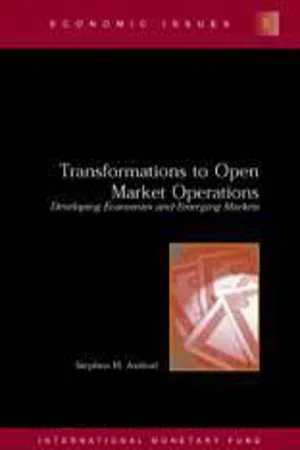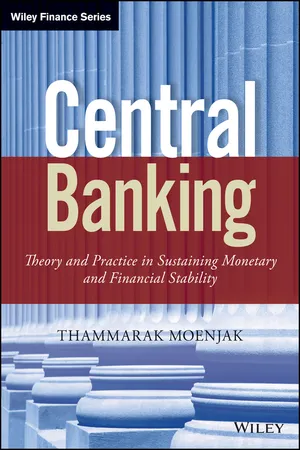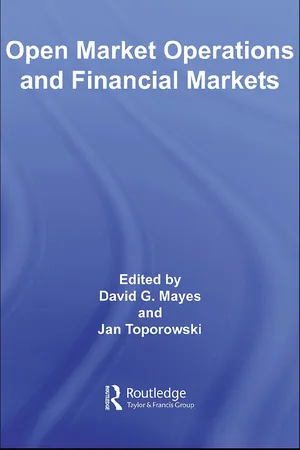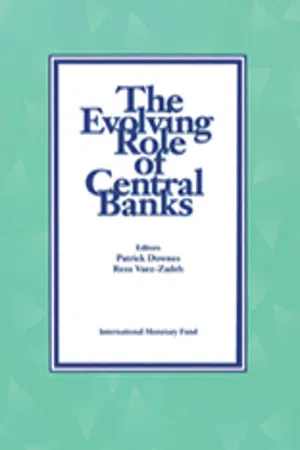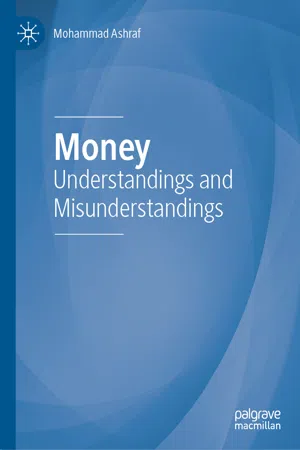Economics
Open Market Operations
Open market operations refer to the buying and selling of government securities by a central bank in the open market to control the money supply and influence interest rates. When a central bank wants to increase the money supply, it buys government securities, and when it wants to decrease the money supply, it sells government securities. These operations are a key tool for implementing monetary policy.
Written by Perlego with AI-assistance
Related key terms
5 Key excerpts on "Open Market Operations"
- International Monetary Fund(Author)
- 1997(Publication Date)
- INTERNATIONAL MONETARY FUND(Publisher)
Transformations to Open Market Operations: Developing Economies and Emerging Markets
By buying or selling bonds, bills, and other financial instruments in the open market, a central bank can expand or contract the amount of reserves in the banking system and can ultimately influence the country’s money supply. When the central bank sells such instruments it absorbs money from the system. Conversely, when it buys it injects money into the system. This method of trading in the market to control the money supply is called Open Market Operations.Open Market Operations are the major instrument of monetary control in industrial countries and are becoming important to developing countries and economies in transition. Open Market Operations allow central banks great flexibility in the timing and volume of monetary operations at their own initiative, encourage an impersonal, businesslike relationship with participants in the marketplace, and provide a means of avoiding the inefficiencies of direct controls. Developing indirect controls is important to the process of economic development because, as a country’s markets expand, direct controls tend to become less effective, and markets eventually find a way around them, especially in a global world economy. With more countries seeking to deregulate and unleash the potential of market forces, many policymakers and central bankers are grappling with ways to realize the full benefits of Open Market Operations.For such operations to become part of monetary policy, however, other monetary instruments now in place need to be adjusted and the market infrastructure must be transformed. This paper assesses the options available to a central bank for addressing these matters and designing instruments for implementing Open Market Operations. First, it provides a brief review of the connection between Open Market Operations and other monetary operations. Then, it discusses how the central bank can encourage development of the necessary financial market architecture. Finally, it reviews the advantages and limitations of specific approaches to Open Market Operations.- eBook - ePub
Central Banking
Theory and Practice in Sustaining Monetary and Financial Stability
- Thammarak Moenjak(Author)
- 2014(Publication Date)
- Wiley(Publisher)
By announcing its intention to keep the policy interest rate at a particular level, the central bank can induce participants in the money market to borrow and lend among themselves at rates that are not too far off from the policy interest rate. Normally, market participants are encouraged to borrow and lend among themselves first before turning to the central bank. Competition among market participants would normally ensure that they borrow and lend among themselves at rates that are not too extreme. 16 Yet, if it seems that shortages or surpluses of funds would not be cleared easily at rates of interest near the policy interest rate, then the central bank can always step in and inject or drain out funds from market participants directly, through Open Market Operations. With the knowledge that the central bank can always step in to ensure that rates do not go much out of line with the policy interest rate, market participants would normally borrow and lend near or at the policy rate anyhow. This, of course, is unless there is a large systemic shortage or surplus of funds that drives market participants to borrow and lend at rates far removed from the policy rate. 17 Open Market Operations When conducting Open Market Operations, central bank injects or absorbs funds from the money market at the margin, so as to prevent excessive net shortages or surpluses of funds from driving a large wedge between prevailing interest rates and the policy rate. 18 Open Market Operations normally means purchasing and selling of securities (normally government securities and central bank bills) to market participants. With a purchase of securities, the central bank is effectively injecting funds into the system, since the central bank has to pay for those securities with money - eBook - ePub
- David Mayes, Jan Toporowski(Authors)
- 2007(Publication Date)
- Routledge(Publisher)
4 Open Market Operations – their role and specification todayUlrich Bindseil and Flemming Würtz*Although used by central banks in the nineteenth century, Open Market Operations were only explicitly praised as a supposedly superior tool of central bank policy in the early 1920s. This ‘discovery’ of Open Market Operations occurred in tandem with the rise of reserve position doctrine and the dismissal of the traditional steering of short-term interest rates mainly through setting of the discount rate. The idea of a purely quantitative transmission mechanism and the associated supremacy of Open Market Operations survived, until recently, in particular amongst US academics. Only the unambiguous return to interest rate steering by the Fed in the 1990s and the appearance of new academic impulses as exemplified by Taylor (1993) and Woodford (2003), who put no emphasis on monetary quantities as operational targets of monetary policy, seem to have also put into question the belief in the supremacy of Open Market Operations and in the evil of standing facilities. Nevertheless, undergraduate text books still continue to devote ample space to the money multiplier, which makes so little sense under the new consensus.This chapter revisits the role and specification of Open Market Operations after the fall of the reserve position doctrine and the return to explicit short-term interest rate steering by central banks. The next section provides a short summary of the rise and fall of the reserve position doctrine, and in particular of the associated evolution of the perceived role of Open Market Operations. It is followed by a section defining and distinguishing ‘Open Market Operations’ and ‘standing facilities’ more precisely and providing a short classification of monetary policy implementation approaches into ‘Open Market Operations based’ and ‘standing facilities based’ ones. It highlights a kind of continuum between the two types of operation and between the two types of approach. Given the unambiguous return to short-term interest rate steering, a simple model is used to argue that standing facility based approaches may appear more efficient than the relatively complicated open market based approaches, which are applied by most central banks today. - eBook - ePub
- INTERNATIONAL MONETARY FUND(Author)
- 1991(Publication Date)
- INTERNATIONAL MONETARY FUND(Publisher)
Traditional Open Market Operations require relatively deep secondary markets. For such operations to work, both the central bank and banks or other market participants would need to hold or be prepared to hold government or other securities that can be traded—and at low risk. By buying and selling securities out of its own portfolio or conducting repurchase operations and similar transactions, the central bank could influence liquidity conditions and interest rates in the market. This is clearly the most flexible and market-based instrument for monetary control. But it is also one that is beyond most countries’ reach—even in the medium term—because few countries can expect to have money markets that are deep enough for such transactions on a major scale.Open Market-Type Operations
The fact that there is no deep money market does not mean that one cannot conduct transactions with similar effects as those of Open Market Operations. One can approximate the effects of such operations by developing and conducting transactions in the primary market for short-term bills. Such operations could be called open market-type operations. The idea would be to use the primary issuing process as the mechanism for selling bills at market prices. Such bills could be issued either by the central bank itself or by the government.There is always a question whether it is better to issue government or central bank bills. It would clearly be preferable to use government bills with interest paid by the government. The central bank could act as its agent and issue government bills according to monetary criteria, including, in particular, market interest rates. But if such issuing is done for monetary control purposes, the government should be prepared to deposit any excess over its programmed financing needs in the central bank. If the government were to spend the excess, it would not be sterilized and therefore would not have the desired monetary effect. These conditions may not be met. There could be legal impediments, or the government could be unwilling to sterilize the proceeds and would rather spend them. It may, therefore, be necessary for the central bank to issue its own securities. This could take the form of certificates of deposit or bills. - eBook - ePub
Money
Understandings and Misunderstandings
- Mohammad Ashraf(Author)
- 2020(Publication Date)
- Palgrave Macmillan(Publisher)
Fed conducts Open Market Operations, it buys and sells already existing government securities—Treasury bills, Treasury notes, and Treasury bonds, but most often Treasury bills—in the open market. It does not buy brand new securities. That is, the Fed does not lend directly to the US Treasury. A purchase of government security is called an open market purchase, and a sale of government security is called an open market sale.Take the example of a Treasury bill that you bought, say for $97.00. Its maturity date is one month from today. Suppose that you need the funds now. You can resell this Treasury bill to someone else who is willing to lend to the US Treasury. What is actually happening is that you are transferring the right to collect the face value of the Treasury bill to someone else. In return, you are getting the funds today. The price at which you may sell the Treasury bill is determined in the open market. Suppose the buyer of this bill is the Fed . In this case, we will say that the Fed has conducted an open market purchase.This action by the Fed triggers a series of events. Suppose you sold the Treasury bill for $97.00. The Fed wrote you a check in that amount. You deposited that check in your bank. The bank then deposits the check in its account with the Fed. The Fed increases the amount of reserves that the said bank has. Let’s look at the equation from Chapter 4 , Eq. 4.1 , reproduced here.Note that the ΔR has increased by $97.00. Suppose that the required reserve ratio, rr , is 10 percent. This means that the value of the money multiplier , , is 10. A change in reserves of $97.00 will lead to a change in demand deposits, ΔD , of $970.00. The Fed has increase money supply by $970.00.In this example, we are assuming that the bank extends the loans. If the bank, however, does not want to extend loans or does not have any borrower at the time, then the bank has more reserves than it needs. It may lend those reserves to some other bank that has fewer reserves than it needs to meet its reserve requirements. In the second scenario, the lending bank will charge an interest rate . Holding everything else constant, the interest rate that banks charge each other for overnight loans—the federal funds rate—will decrease (more below). Either way, there is an increase in reserves in the banking system. As a result, money supply increases. The M s curve in Fig. 5.1 shifts to the right. The reverse happens when the Fed sells government securities; money supply decreases and the M s curve in Fig. 5.1
Index pages curate the most relevant extracts from our library of academic textbooks. They’ve been created using an in-house natural language model (NLM), each adding context and meaning to key research topics.
